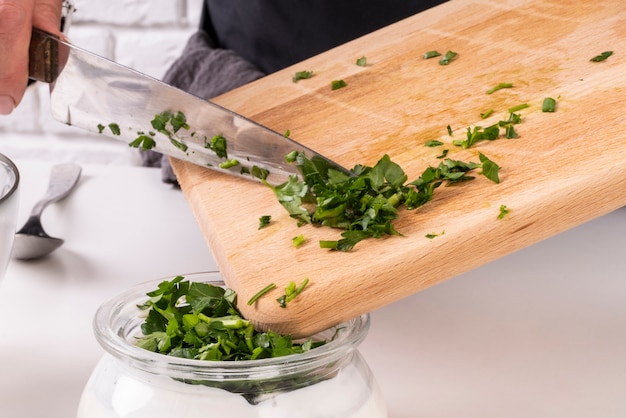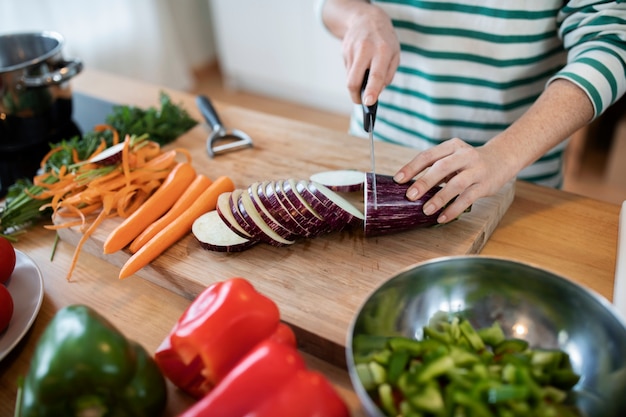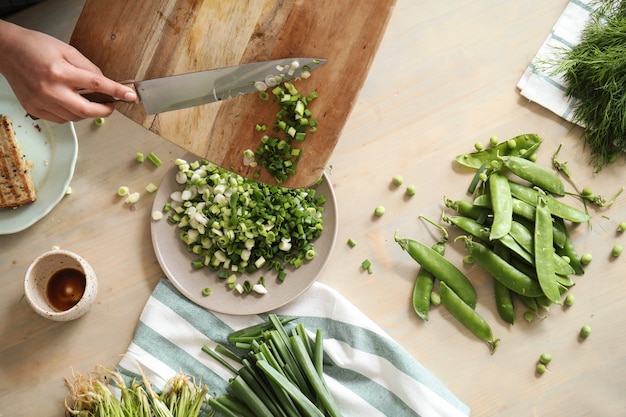Let's be honest, there's something about the arrival of spring that makes you crave fresh, vibrant flavours. And for me, nothing screams "springtime" quite like a plate of fiddleheads. These little coiled-up bundles of green are a real treat, and they're not just a beautiful sight, they pack a punch of flavour and texture. Now, you might be thinking, "Fiddleheads? What are those?" Well, let me tell you, they're a bit of a culinary mystery for many, but once you get to know them, they'll become a spring favourite. In this guide, we're going to delve into the world of fiddleheads, from the basics of identifying and prepping them to creating some truly delicious recipes. Buckle up, because it's about to get tasty!
(Part 1) Fiddleheads 101: Unraveling the Mystery

Alright, let's start with the basics. Fiddleheads are actually the young, unfurling fronds of certain types of ferns, and they get their name from their resemblance to the scrolled head of a violin. But here's the thing, not all ferns are edible. So, before you go out foraging, it's important to know what you're looking for.
Identifying Edible Fiddleheads: Spotting the Good Guys
The most common edible fiddleheads come from Ostrich ferns and Lady ferns. Both have a similar curled shape, but there are a few key differences:
- Ostrich Ferns: These guys are the big and sturdy ones. Their stems are thick and fleshy, almost like a miniature asparagus stalk, and they have a distinctive brown colour. The fiddleheads are usually about 6-8 inches long.
- Lady Ferns: These are a bit more delicate and smaller. Their stems are thinner and have a lighter green colour. You’ll usually find Lady fern fiddleheads in clusters.
Now, let's get serious for a moment. This is where I get a bit preachy. I love the thrill of foraging, but safety should always come first. If you're not 100% sure what you're picking, leave it be! There are some ferns that are poisonous, and it's simply not worth the risk. If you're unsure, ask an experienced forager or stick to buying your fiddleheads from reputable sources.
Fiddlehead Preparation: Getting Ready for the Feast
You've got your fiddleheads, now it's time to prep them for cooking. This isn't a complicated process, but it's important for getting the most out of these springy wonders. Think of it as the final stage of the foraging journey before you begin the culinary adventure.
- Cleaning: Gently rinse the fiddleheads under cold water to remove any dirt or debris. Don't soak them too long, as this can make them soggy.
- Trimming: The base of the fiddlehead is tough and fibrous, so you need to get rid of it. Use a sharp knife to trim off the very bottom, leaving only the tender part.
- Optional Blanching: This step isn't mandatory, but it can help to remove any bitterness and make the fiddleheads more tender. Simply blanch them in boiling water for a couple of minutes before proceeding with your recipe.
(Part 2) The Many Faces of Fiddleheads: A Culinary Adventure

Now, the fun part! Fiddleheads are incredibly versatile. They have a delicate, slightly earthy flavour that's both refreshing and unique. Think of them as a culinary blank canvas, ready for your creative touch. I've had my fair share of culinary adventures with these spring delights, and I'm always on the lookout for new ways to enjoy them. Let's explore some of the possibilities.
Simple Sautéed Fiddleheads: A Classic Start
For those new to fiddleheads, this is the perfect way to begin. It lets their natural flavour shine through without any fancy techniques. All you need is some olive oil, salt, pepper, and a sprinkle of garlic for extra oomph (optional, of course).
The secret is in the cooking. Sauté the fiddleheads in a skillet over medium heat until they're tender-crisp. You'll know they're ready when they’ve lost their curl and turned a beautiful vibrant green. Season with salt and pepper to taste, and for an extra touch, add a squeeze of lemon juice for a bit of brightness and some fresh herbs like parsley or chives for a fragrant finish.
Fiddleheads in Soups and Stews: A Touch of Springtime
Fiddleheads add a wonderful textural contrast to soups and stews. Their mild flavour blends beautifully with a wide range of broths and ingredients, whether you’re going for an earthy or lighter soup.
Add them in the last 10-15 minutes of cooking so they retain their beautiful green colour and a bit of their crunch. Imagine a creamy mushroom soup with the addition of fiddleheads, or a hearty lentil stew with a handful of these springy delights. It's a lovely way to bring a touch of spring into your comfort food.
Fiddleheads in Stir-Fries: A Fusion Delight
Fiddleheads are surprisingly versatile and play well with a wide range of flavours and spices. I love how they stand out in a stir-fry, adding their unique texture and taste to the mix. Their mild flavour works beautifully with bold Asian-inspired flavours.
Think of a stir-fry with ginger, garlic, soy sauce, and chilli, with fiddleheads adding their unique touch. You can also add them to a tofu stir-fry for a protein-packed meal, or even try them with some shrimp for a seafood-inspired dish.
(Part 3) Beyond the Basics: Exploring Fiddlehead Flavours

Alright, so now we're venturing beyond the simple but delicious. Let's get creative and explore some more adventurous ways to enjoy fiddleheads. Think of it as stepping into a culinary playground, where we can experiment with flavours and textures, and have a little fun.
Fiddlehead Fritters: A Crispy Treat
Imagine this: a crispy, golden-brown fritter filled with tender fiddleheads, bursting with flavour. It's a delicious way to enjoy these springtime delights, and surprisingly easy to make.
The key is the batter. You want it to be thin enough to coat the fiddleheads but thick enough to hold its shape. A mixture of flour, cornmeal, and a bit of baking powder is a great starting point. You can also add chopped onion or herbs for extra flavour. After dipping the fiddleheads in the batter, fry them in hot oil until golden brown and crispy. Serve them with a dollop of sour cream or a drizzle of honey for a sweet and savoury treat.
Fiddlehead Salad: A Springtime Symphony
Who says salads have to be boring? Fiddleheads bring a unique flavour and texture to any salad, making it a springtime sensation.
You can go for a simple salad with just fiddleheads, a light vinaigrette, and some toasted nuts for crunch. Or you could get a bit more adventurous and create a salad with other spring vegetables like asparagus, peas, and radishes. Add a bit of goat cheese or crumbled feta for a creamy element, and you've got yourself a truly delightful spring salad.
(Part 4) Fiddlehead Recipes: Time to Get Cookin'
Enough with the chat, let's get down to business. It’s time for some real-deal recipes that’ll have your taste buds singing. I’ve chosen a few favourites that showcase the versatility of fiddleheads. I’ll walk you through the steps, but feel free to experiment and add your own twists. That's the beauty of cooking - there’s no right or wrong, just delicious exploration.
Recipe 1: Fiddlehead Salad with Lemon Vinaigrette
This salad is a fresh and vibrant delight, perfect for a light lunch or a side dish. The tartness of the lemon vinaigrette perfectly complements the delicate flavour of the fiddleheads.
Ingredients:
- 1 pound fresh fiddleheads, cleaned and trimmed
- 1/2 cup olive oil
- 1/4 cup lemon juice
- 1 tablespoon Dijon mustard
- 1 teaspoon sugar
- Salt and pepper to taste
- 1/4 cup toasted walnuts or pecans
- 1/4 cup crumbled goat cheese or feta
Instructions:
- Blanch the fiddleheads in boiling water for 2 minutes. Drain and refresh with cold water.
- In a small bowl, whisk together the olive oil, lemon juice, Dijon mustard, and sugar. Season with salt and pepper to taste.
- In a large bowl, combine the fiddleheads, toasted nuts, and cheese. Pour the dressing over the salad and toss to coat.
- Serve immediately.
Recipe 2: Fiddlehead and asparagus stir-fry
This stir-fry is a symphony of spring flavours, with the fiddleheads and asparagus playing the lead roles. The ginger and garlic add a touch of heat, while the soy sauce provides a salty umami punch.
Ingredients:
- 1 pound fresh fiddleheads, cleaned and trimmed
- 1 pound fresh asparagus, trimmed
- 1 tablespoon olive oil
- 1 tablespoon grated ginger
- 2 cloves garlic, minced
- 1/4 cup soy sauce
- 1 tablespoon honey
- 1 teaspoon sesame oil
- Salt and pepper to taste
- 1/4 cup chopped green onions, for garnish
Instructions:
- Blanch the fiddleheads and asparagus in boiling water for 2 minutes. Drain and refresh with cold water.
- Heat the olive oil in a wok or large skillet over medium-high heat. Add the ginger and garlic and cook for 30 seconds, until fragrant.
- Add the fiddleheads, asparagus, soy sauce, honey, and sesame oil. Stir-fry for 2-3 minutes, until the fiddleheads and asparagus are tender-crisp.
- Season with salt and pepper to taste.
- Serve immediately, garnished with chopped green onions.
Recipe 3: Creamy Fiddlehead Soup
This soup is a creamy and comforting delight, perfect for a chilly spring evening. The fiddleheads add a unique flavour and texture, while the creaminess of the soup is a perfect contrast.
Ingredients:
- 1 pound fresh fiddleheads, cleaned and trimmed
- 1 tablespoon olive oil
- 1 onion, chopped
- 2 cloves garlic, minced
- 4 cups vegetable broth
- 1 cup heavy cream
- Salt and pepper to taste
- 1/4 cup chopped fresh dill, for garnish
Instructions:
- Blanch the fiddleheads in boiling water for 2 minutes. Drain and refresh with cold water.
- Heat the olive oil in a large pot over medium heat. Add the onion and cook for 5 minutes, until softened. Add the garlic and cook for 1 minute more.
- Add the fiddleheads and vegetable broth to the pot. Bring to a boil, then reduce heat and simmer for 15 minutes.
- Using an immersion blender, blend the soup until smooth. Stir in the heavy cream. Season with salt and pepper to taste.
- Serve hot, garnished with chopped fresh dill.
(Part 5) Fiddlehead Storage: Keeping Those Springy Delights Fresh
You've got your fiddleheads, but now you need to store them properly so they don't go to waste. Here's the thing: Fiddleheads are best enjoyed fresh, so try to use them as soon as possible after purchasing or foraging. But if you need to store them, here’s what to do.
- Refrigerator Storage: Store unwashed fiddleheads in a plastic bag in the refrigerator. They'll last for about 3-5 days.
- Freezing Fiddleheads: You can freeze fiddleheads for longer storage, but they may lose some of their texture and flavour. Blanch them first, then freeze in a freezer-safe bag.
(Part 6) The nutritional powerhouse: Fiddleheads and Their Benefits
Alright, so these fiddleheads are delicious, but they're also good for you! They’re packed with vitamins and minerals, making them a healthy and tasty addition to your diet. Here’s the lowdown:
- High in Vitamin C: A single serving of fiddleheads can provide a good dose of Vitamin C, which is an antioxidant and helps boost your immune system.
- Rich in Iron: Fiddleheads are a good source of iron, which is essential for red blood cell production and oxygen transport throughout the body.
- Packed with Fiber: Fiddleheads are also a good source of dietary fiber, which is important for digestive health.
- Other Nutrients: They're also a good source of potassium, magnesium, and folate.
(Part 7) A Bit of History: Fiddleheads in Culture
There's a whole world of stories and traditions surrounding fiddleheads, reaching back to ancient times. They’ve played a role in various cultures and have been a part of culinary traditions for centuries.
In some indigenous cultures, fiddleheads were considered a sacred food, symbolizing the rebirth and renewal of spring. In others, they were a staple food source, providing sustenance and nourishment during the spring months. Today, fiddleheads continue to be enjoyed by people all over the world, as a delicious and unique springtime treat.
(Part 8) FAQs: Your Fiddlehead Queries Answered
I get a lot of questions about fiddleheads, so I’ve compiled some of the most common ones and provided detailed answers.
1. Are all ferns edible?
No, not all ferns are edible. It's crucial to identify the correct type of fern before consuming any fiddleheads. Stick to Ostrich ferns and Lady ferns, which are commonly eaten. If you're unsure, don't eat it!
2. How do I know if fiddleheads are fresh?
Fresh fiddleheads should be firm and tightly coiled. They should also have a bright green colour, without any browning or discoloration. Avoid any fiddleheads that are limp, wilted, or have a strong odour.
3. Are fiddleheads poisonous?
Fiddleheads can contain a toxin called thiaminase, which can interfere with the absorption of thiamine (vitamin B1). This toxin is destroyed by cooking, so it's important to cook fiddleheads thoroughly before eating them.
4. What is the best way to cook fiddleheads?
The best way to cook fiddleheads is to blanch them first, which helps to remove bitterness and make them more tender. Then you can sauté them, add them to soups, stews, or stir-fries, or use them in salads or fritters.
5. Where can I buy fresh fiddleheads?
You can usually find fresh fiddleheads at farmers' markets or specialty food stores during the spring season. If you're lucky, you might even find them at some supermarkets.
(Part 9) Final Thoughts: A Springtime Delight
Well, there you have it! I hope you’ve enjoyed this journey into the world of fiddleheads. It’s been a pleasure sharing my passion for these springtime delights with you. Whether you’re a seasoned forager or a newbie, I hope this guide has equipped you with the knowledge and inspiration to explore the unique flavours and textures of fiddleheads.
So, next time you see a bunch of fiddleheads at the market, don’t hesitate. Grab them, give them a try, and let them transport you to the vibrant and delicious world of spring. You won’t regret it!
Everyone is watching

Perfect Rice Every Time: The Ultimate Guide to Cooking Rice
Cooking TipsAs a self-proclaimed foodie, I've always been a bit obsessed with rice. It's the foundation of countless cuisi...

Prime Rib Roast Cooking Time Chart: Per Pound Guide
Cooking TipsPrime rib roast. Just the name conjures images of lavish dinners, crackling fires, and hearty laughter. It’s ...

The Ultimate Guide to Cooking Asparagus: Tips, Techniques, and Recipes
Cooking TipsAsparagus. The mere mention of this spring delicacy conjures up images of vibrant green spears, crisp and burs...

Ultimate Guide to Cooking the Perfect Thanksgiving Turkey
Cooking TipsThanksgiving. Just the word conjures up images of overflowing tables laden with delicious food, the scent of r...

How Long to Bake Potatoes in the Oven (Perfect Every Time)
Cooking TipsBaked potatoes are a staple in my kitchen. They're incredibly versatile, delicious, and surprisingly easy to m...
